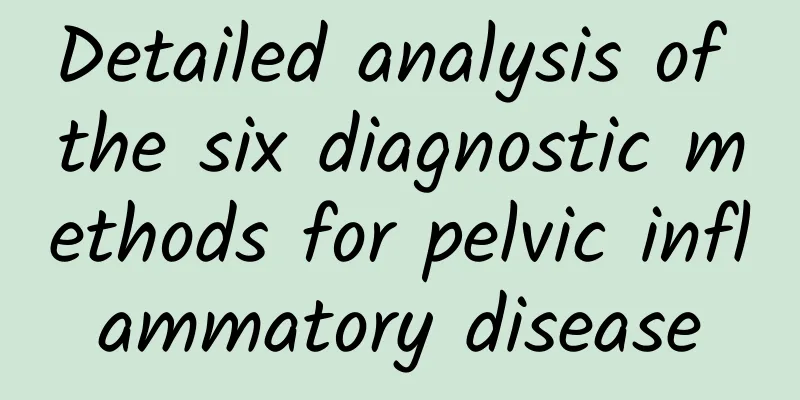Detailed analysis of the six diagnostic methods for pelvic inflammatory disease

|
Pelvic inflammatory disease has been on the rise in recent years. For most patients, the first thing to pay attention to is the diagnosis method of pelvic inflammatory disease. What are the diagnosis methods of pelvic inflammatory disease? The following article will analyze the diagnosis methods of pelvic inflammatory disease in detail. (1) Direct smear sampling of secretions can be vaginal, endocervical, or urethral secretions, or peritoneal fluid (obtained through the posterior fornix, abdominal wall, or through laparoscopy), and direct thin-layer smears are made. After drying, they are stained with methylene blue or Gram. If Gram-negative diplococci are seen in polymorphonuclear leukocytes, it is a gonorrheal infection. Because the detection rate of endocervical gonorrhea is only 67%, a negative smear cannot exclude the presence of gonorrhea, and a positive smear is very specific. Fluorescein monoclonal antibody dye can be used for microscopic examination of Chlamydia trachomatis. Any star-shaped flashing fluorescent spots observed under a fluorescence microscope are positive. These are all diagnostic methods for pelvic inflammatory disease. (2) The pathogen culture specimens are from the same source as above. They should be inoculated on Thayer-Martin medium immediately or within 30 seconds and cultured in a 35°C incubator for 48 hours to identify bacteria by glycolysis. The new relatively rapid chlamydial enzyme assay has replaced the traditional chlamydia detection method. Mammalian cell culture can also be used to detect Chlamydia trachomatis antigens. This method is an enzyme-linked immunosorbent assay. The average sensitivity is 89.5% and the specificity is 98.4%. Bacteriological culture can also obtain other aerobic and anaerobic strains and serve as a basis for selecting antibiotics. (3) Posterior fornix puncture Posterior fornix puncture is one of the most commonly used and valuable diagnostic methods for pelvic inflammatory disease in gynecological acute abdomen. Through puncture, the contents of the abdominal cavity or the rectouterine fossa, such as normal peritoneal fluid, blood (fresh, old, clotted blood, etc.), purulent secretions or pus, can further clarify the diagnosis. Microscopic examination and culture of the punctured material are even more necessary. (4) Ultrasound examination mainly includes B-type or grayscale ultrasound scanning and filming. This technology has an 85% accuracy in identifying masses or abscesses formed by adhesions of the fallopian tubes, ovaries and intestines. However, it is difficult to show the characteristics of mild or moderate pelvic inflammatory disease in B-type ultrasound images. (5) If the patient is not suffering from diffuse peritonitis and is in good general condition, laparoscopy can be performed on patients with pelvic inflammatory disease, suspected pelvic inflammatory disease, or other acute abdominal diseases. Laparoscopy can not only confirm the diagnosis and differential diagnosis, but also make a preliminary assessment of the severity of pelvic inflammatory disease. (6) Examination of male partners This is helpful for the diagnosis of female pelvic inflammatory disease. The urethral secretions of the male partner can be directly smeared or cultured for gonorrhea. If positive, it is strong evidence, especially in patients with no symptoms or mild symptoms. Or more white blood cells can be found. If all male partners of PID patients are treated, regardless of whether they have symptoms of urethritis, it is obviously very meaningful to reduce recurrence. The information explained above is all about the diagnosis methods of pelvic inflammatory disease. I hope it can help you. Today, the expert introduces the diagnosis methods of pelvic inflammatory disease. If you still have any questions about the diagnosis methods of pelvic inflammatory disease, you can consult our online experts and they will give you detailed answers. |
<<: Ten key points to prevent pelvic inflammatory disease
>>: Seven detailed reasons for cervical hypertrophy
Recommend
How to treat acute cervicitis completely
In the clinical treatment of acute cervicitis, ta...
How to treat uterine fibroids and ovarian cysts
The treatment of uterine fibroids and ovarian cys...
What harm does cervicitis do to the human body?
Cervicitis is one of the common gynecological dis...
What is pelvic inflammatory disease in traditional Chinese medicine? Which acupoints can be massaged to treat pelvic inflammatory disease?
What is pelvic inflammatory disease in traditiona...
What are the symptoms of chronic cervicitis in women? Introduction to the symptoms of chronic cervicitis in women
In life, many women do not pay attention to perso...
What should I do if I have uterine fibroids two months into my pregnancy? Can I continue to be pregnant?
Having children is a woman's natural duty, an...
Why does Bartholinitis keep recurring?
Gynecologists point out that the Bartholin's ...
What is tubal pregnancy like?
Tubal pregnancy is a common disease, and patients...
What will happen if pelvic inflammatory disease patients are not cured in time?
Female friends should pay more attention to pelvi...
What medicine should I take for cervical erosion?
Cervical erosion can generally be treated with me...
What to do if cervical erosion is third degree
Third degree cervical erosion does sound a bit wo...
Teacher Annie teaches you 3 yoga slimming tricks to easily create slender legs
Are you always dissatisfied with your body shape,...
Can menopause be cured?
Every woman will experience menopause, so you sho...
Stress hormones make people fat! 4 ways to avoid stress obesity
Moderate stress can boost motivation, but long-te...
Cervical precancerous lesions medication guide
Women are important members of the family. Work, ...









